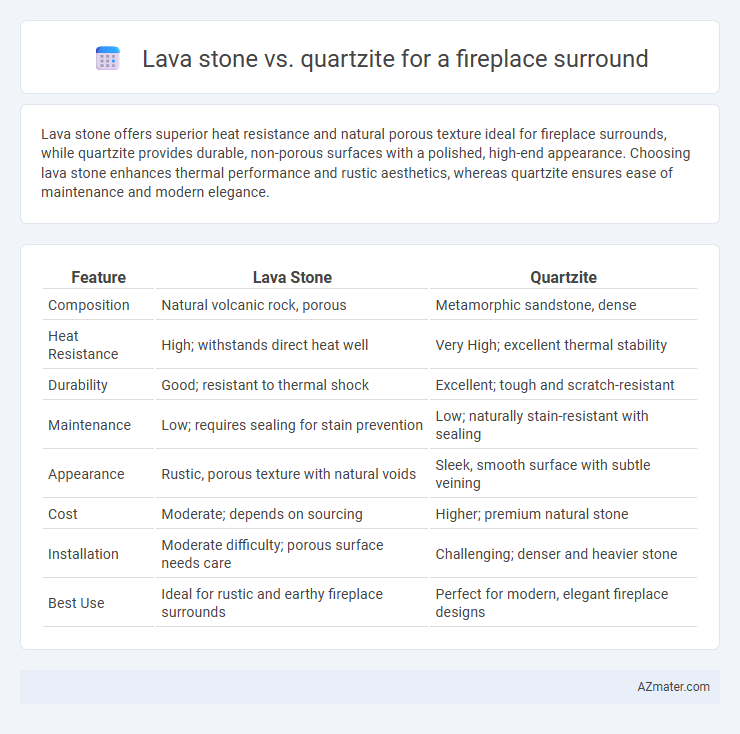Lava stone offers superior heat resistance and natural porous texture ideal for fireplace surrounds, while quartzite provides durable, non-porous surfaces with a polished, high-end appearance. Choosing lava stone enhances thermal performance and rustic aesthetics, whereas quartzite ensures ease of maintenance and modern elegance.
Table of Comparison
| Feature | Lava Stone | Quartzite |
|---|---|---|
| Composition | Natural volcanic rock, porous | Metamorphic sandstone, dense |
| Heat Resistance | High; withstands direct heat well | Very High; excellent thermal stability |
| Durability | Good; resistant to thermal shock | Excellent; tough and scratch-resistant |
| Maintenance | Low; requires sealing for stain prevention | Low; naturally stain-resistant with sealing |
| Appearance | Rustic, porous texture with natural voids | Sleek, smooth surface with subtle veining |
| Cost | Moderate; depends on sourcing | Higher; premium natural stone |
| Installation | Moderate difficulty; porous surface needs care | Challenging; denser and heavier stone |
| Best Use | Ideal for rustic and earthy fireplace surrounds | Perfect for modern, elegant fireplace designs |
Introduction to Lava Stone and Quartzite for Fireplaces
Lava stone, formed from volcanic activity, offers excellent heat resistance and natural texture, making it a popular choice for fireplace surrounds. Quartzite, a durable metamorphic rock composed primarily of quartz, provides a sleek, polished appearance with high heat tolerance and scratch resistance. Both materials combine aesthetic appeal with functional durability, enhancing the safety and style of fireplace installations.
Aesthetic Differences: Lava Stone vs Quartzite
Lava stone offers a rugged, textured appearance with natural pits and a matte finish, creating a rustic and earthy ambiance for a fireplace surround. Quartzite exhibits a smooth, polished surface with subtle veining and a range of color variations from whites to blues and grays, lending a sophisticated and elegant look. The aesthetic differences highlight lava stone's bold, organic feel compared to quartzite's refined, sleek style, allowing homeowners to choose based on desired visual impact and interior design theme.
Durability and Heat Resistance Compared
Lava stone offers exceptional heat resistance and durability, making it ideal for high-temperature applications like fireplace surrounds due to its volcanic origin and dense composition. Quartzite, a natural metamorphic rock, also provides strong heat resistance and durability but may be more prone to cracking under extreme thermal stress compared to lava stone. Both materials withstand fireplace conditions well, yet lava stone typically excels in longevity and thermal stability, ensuring a longer-lasting, safer fireplace surround.
Maintenance Requirements: Which Is Easier?
Lava stone requires minimal maintenance due to its porous, heat-resistant nature, making it resistant to stains and easy to clean with mild soap and water. Quartzite, while highly durable and heat-resistant, demands more frequent sealing to prevent staining and moisture absorption, which can complicate upkeep. For a fireplace surround, lava stone is generally easier to maintain, offering a natural textured surface that withstands heat and dirt without extensive care.
Cost Comparison: Lava Stone vs Quartzite
Lava stone fireplace surrounds typically cost between $20 to $40 per square foot, making them a more budget-friendly option compared to quartzite, which ranges from $50 to $100 per square foot due to its natural durability and aesthetic appeal. Installation expenses for both materials vary, but quartzite often requires specialized labor increasing overall costs, while lava stone benefits from more straightforward handling. Long-term maintenance costs for lava stone are lower because of its heat resistance and low porosity, whereas quartzite may incur additional sealing and care expenses to preserve its finish.
Installation Process and Practical Considerations
Lava stone is lightweight and easier to cut, simplifying installation and reducing labor costs, whereas quartzite's hardness demands specialized tools and skilled labor, increasing complexity and expense. Lava stone's porous nature requires sealing to prevent staining, while quartzite offers greater natural resistance to heat and moisture, enhancing durability around fireplaces. Practical considerations include lava stone's lower thermal conductivity for safer surfaces, against quartzite's superior strength and aesthetic appeal for long-term use.
Environmental Impact and Sustainability
Lava stone offers a low environmental impact due to its natural volcanic origin and minimal processing requirements, making it a sustainable choice for fireplace surrounds. Quartzite, while durable and long-lasting, requires extensive quarrying and energy-intensive processing, leading to a higher carbon footprint. Choosing lava stone supports eco-friendly building practices by reducing carbon emissions and promoting the use of naturally abundant materials.
Customization and Design Options
Lava stone offers unique textures and natural variations that enhance custom fireplace surround designs with a rustic, volcanic aesthetic. Quartzite provides a broader color palette and consistent patterns, ideal for sleek, modern customization with polished or honed finishes. Both materials support intricate cuts and shapes, allowing for tailored installations that suit diverse interior styles.
Pros and Cons of Lava Stone Fireplaces
Lava stone fireplaces offer exceptional heat retention and unique, rustic aesthetics due to their porous texture and natural volcanic origins, making them ideal for cozy, energy-efficient spaces. Their durability and resistance to high temperatures prevent cracking and warping, but the porous surface can absorb soot and dust, requiring regular cleaning and sealing to maintain appearance. Compared to quartzite, lava stone provides better thermal insulation but may be heavier and more challenging to install, impacting overall fireplace surround design flexibility.
Pros and Cons of Quartzite Fireplaces
Quartzite fireplaces offer exceptional durability and natural beauty, with heat-resistant properties that make them ideal for fireplace surrounds. The dense, hard surface of quartzite resists scratches and heat damage better than lava stone, but it can be more expensive and challenging to install due to its hardness and weight. Quartzite's unique veining and color variations provide a sophisticated aesthetic, though it requires regular sealing to prevent staining and maintain its appearance over time.

Infographic: Lava stone vs Quartzite for Fireplace surround
 azmater.com
azmater.com